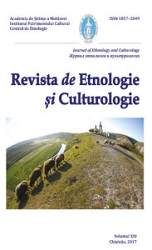Pâinea în ritualurile de naştere ale găgăuzilor
Bread in the Gagauz birth rituals
Author(s): Evdochia SoroceanuSubject(s): History
Published by: Institutul Patrimoniului Cultural al Academiei de Științe a Moldovei
Keywords: the Gagauz; Gagauz ritualism; birth feast; birth bread; pita
Summary/Abstract: Bread is one of the most meaningful symbols in the Gagauz traditional culture. In the article, bread is considered in the context of the birth feast (“pita”) and post-natal rituals (the baptizing, first step, first haircut, first tooth, child’s weaning and so on), that represent a convoluted complex of magic actions, in which the pagan and Christian beliefs of the Gagauz are intertwined. The bread baked from unleavened dough (pita, corek, kolac) occupies the most important place in the ritual practice. However, not less important attributes are the wheat grains and flour (for example, in such rituals as the new-born’s first bathing, the ritual of new mother’s feeding with “koliva”, gift exchange between the rituals’ participants and so on) that have a productive function. The ritual bread is characterized by polysemy (destiny, fate, life’s course, marriage, health, wealth, charm) and the poly-functionality (the child’s acceptance into the family and its presentation to the community, the protection from evil spirits, the adult life programming and so on). The birth bread of the Gagauz and the ritual actions performed with it find analogies in other Balkan traditions, especially in Bulgarian and Moldavian. The presence of a big number of common similarities allows to attribute the birth feast’s ritualism of the Gagauz to the Balkan birth feast „text”.
Journal: Revista de Etnologie şi Culturologie
- Issue Year: XXI/2017
- Issue No: 1
- Page Range: 22-28
- Page Count: 7
- Language: English, Romanian, Russian

